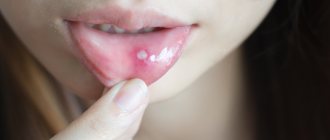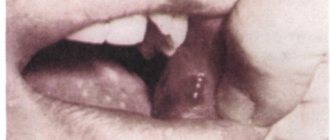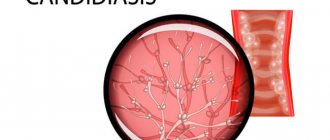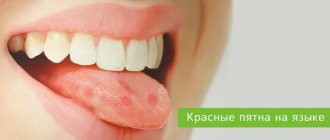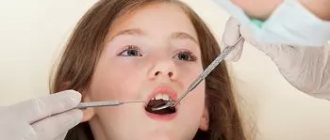From this article you will learn:
- a lump has come out on my lip - what is it?
- what does a cyst look like under the tongue,
- treatment of cysts of the lower lip and under the tongue.
A retention cyst is a convex, rounded formation that occurs as a result of blockage of the duct of one of the small salivary glands located in the thickness of the oral mucosa. Most often, a retention cyst of the lower lip occurs and a little less often - under the tongue. Accidental biting of the lip can lead to the appearance of a cyst, which will cause blockage of the duct of one of the small salivary glands and lead to the accumulation of viscous secretion in it.
The cyst on the lip is soft to the touch and is filled with viscous saliva. If you bite into it, saliva comes out, and the cyst itself collapses and disappears for a while, but after the mucosal defect heals, the cyst is usually filled again with viscous salivary fluid. Therefore, when patients complain that they have a lump on their lip or under their tongue, this is a retention cyst. Its appearance will require you to visit a dental surgeon for a 15-minute surgical operation (with 2-3 stitches).
Retention cyst on the lip: photo
The cyst can be located closer to the surface of the mucous membrane (as if rising above it), or it can be located deeper in the tissues. This is why some patients notice that the bump is inside the lip, while others notice that the bump is on the outside.
Why can a lump appear on the lip?
Lumps on the lips indicate pathological conditions in the body. They appear in diseases and injuries of various origins.
If a lump appears on your lip, the reason may be as follows:
- injury to the lip and oral cavity;
- dental infections;
- viral diseases of various body systems;
- bacterial and fungal inflammatory diseases;
- tumor and cystic neoplasms.
These causes can be divided into pathological, caused by diseases, and normal, caused by other factors.
An example of the appearance of a labial growth in the photo.
Possible diseases
If a seal appears on the lip, it may be caused by the following diseases:
| Disease | Symptoms |
| Respiratory tract infections | With viral and bacterial diseases of the respiratory tract, small red and flesh-colored balls may appear on the outer surface of the mouth. They appear due to decreased immunity, and after recovery they disappear on their own. |
| Stomatitis | Stomatitis is an inflammatory disease of the mucous membranes of the mouth, most often found in children. Depending on the cause of the inflammation, the bump on the inside of the lip may be clear, red, white, blue or dark brown. |
| Candidiasis | With candidiasis, small white bumps form in the oral cavity, painless on palpation. They can be localized on the inside of the lips, gums or tongue. |
| Herpes | When infected with the herpes virus, a round, painful lump forms on the inside of a person’s lips, which is a blister with clear liquid inside. The inflamed area is itchy and may become covered with a purulent crust. |
| Human papillomavirus | A warty, white or flesh-colored growth occurs when infected with HPV. In the early stages of the disease, the tubercle appears in a single copy, after which their number increases, and the edges of the growths merge with each other. |
| Syphilis | A person infected with syphilis develops a chancre near the lip: a small hard ball resembling a subcutaneous pimple. Chancre signals the onset of the disease and disappears when syphilis enters stage 2. |
| Leukoplakia | With leukoplakia, keratinization and thickening of the epithelium on the oral mucosa occurs. Small white growths form inside the lip, on the tongue and gums. If left untreated, they develop into cancer. |
| Lip cancer | When a malignant tumor occurs, a large red or black lump appears on the oral mucosa. It can be localized on the lip, gums or throat. The lump hurts when touched and may bleed. |
Other factors
Other factors that can cause a lump on the lip include:
- Lip injuries
. A retention blood cyst occurs in wounds: when biting, after a cut or after a blow, when wounded by dental instruments during examination and treatment by a doctor. - Burn when eating hot food
. Hot food or drinks cause thermal damage to the lip tissue. Like mechanical injuries, it causes lumps to appear. - Insect bites
. Blisters caused by an insect bite in the mouth area can take a hard form and turn into a lump. - Malocclusion.
The abnormal position of the teeth causes permanent injury to the lips on the inside, leading to the formation of a pineal growth. - Orthodontic problems
. Incorrect installation of braces or dentures, as well as the retention period of orthodontic treatment, can cause mechanical injury to the lip. - Chemical burn.
When taking certain medications and consuming alkali, a burn may occur in the mouth, leading to the appearance of a lump. - Allergic reactions.
Upon contact with an allergen, the patient may experience small white growths in the oral cavity, including on the lips. - Punctures, wearing piercings.
Trauma and constant friction against the lip tissue causes cystic neoplasms with blood located next to the irritant. - Bad habits.
Smoking and drinking alcohol can cause chronic burns. Like a simple thermal burn, it provokes the appearance of neoplasms.
In case of bite pathologies, incorrect installation of braces and dentures, you should consult a specialist: a dentist or orthodontist.
The remaining reasons listed in the list do not require medical intervention.
Treatment with traditional medicine
The etiology and type of lump on the lip determines the treatment method.
Most often, the following means are used to resolve this pathological formation in medical practice:
Surgical intervention - a superficial incision is made in the mucous membrane followed by removal of the lump
Drugs. Treatment of a lump with drugs is prescribed if it occurs as a result of a bacterial, inflammatory or infectious process. When treating such neoplasms, broad-spectrum antibiotics, immunostimulants, anti-inflammatory, analgesic and drugs that accelerate tissue regeneration are used. As local therapy, special dental gels and ointments are prescribed, which have a powerful symptomatic effect.
- Surgical intervention. It is carried out when diagnosing a malignant tumor, a cyst, its recurrence or significant compaction, as well as the rapid growth of a benign lump. A superficial incision is made into the mucous membrane, followed by removal of the lump.
- Injections. Prescribed for the development of inflammatory processes of the mucous membrane. The introduction of corticosteroids and antibiotics helps to stop this process, while effectively relieving symptoms.
- Laser. It is one of the least traumatic types of surgical treatment, after which there are no side effects. It is characterized by a high therapeutic effect and is ideal for patients with periodically appearing bumps on the lips.
- Cryotherapy. It is based on the effect of liquid nitrogen on the cone. Not suitable for removal in all cases. Blistering may be a consequence of this treatment.
Important! Only a doctor can determine which method of therapy will eliminate the lump that is puffed up on the inside of the lip. Strict adherence to medical recommendations and prescriptions will allow you to get rid of this pathological formation in the shortest possible time, while preventing its recurrence and complications.
Which doctor should I contact?
Depending on the cause of the pathology, consultation with the following specialists may be required:
- Dentist: bite pathology, trauma after examination.
- Orthodontist: incorrectly selected and installed braces, dentures.
- Allergist: severe allergic reactions.
- Oncologist: malignant neoplasms on the lip.
- Oral and maxillofacial surgeon: the need to remove a cyst or tumor.
If the lump comes out due to fungal, bacterial or viral infections, treatment will be carried out by a general practitioner, pediatrician or family doctor.
Diagnostics
You can determine why a lump appears on your lip using diagnostic procedures:
- Inspection and palpation of the growth on the lip, detailed questioning of the patient, study of the anamnesis.
- Taking general and biochemical blood and urine tests.
- Hardware studies: ultrasound, x-ray, probing of gland ducts, sialography.
Instrumental diagnostics are used for neoplasms on the lip: cysts, tumors.
Treatment with traditional methods
Alternative medicine is often used as an adjuvant therapy.
The greatest therapeutic effect is achieved by:
- Sage. Used to prepare a decoction. To do this, 30 g of raw material is crushed, 0.5 liters of boiling water is poured in and boiled over low heat for 10 minutes. Afterwards, let it brew until it cools completely, filter and use for irrigating the oral cavity and as a lotion on the bump.
- Sea salt. Antiseptic solutions for rinsing the mouth are prepared on its basis. For 0.25 ml of warm water 1 tsp. salt.
- Propolis. Can be used in the preparation of a mouth rinse solution. Also based on it, ointments are made that improve nutrition and tissue regeneration, stopping the growth of pathogenic microflora. To do this, mix crushed propolis and butter in equal quantities.
- Calendula. On its basis, a tincture is made, which is subsequently used as a lotion or for irrigation of the oral cavity.
- Tea tree oil. Used to prepare compresses for the bump, which are kept overnight. To do this, mix 0.5 tsp. oils with 1 tsp May honey.
Are bumps on the lips dangerous?
The danger of bumps on the lips depends on the cause of their occurrence. Small blisters that appear after eating hot food or an insect bite will not harm the body.
Complications can result from:
- retention cyst caused by trauma;
- inflammation due to infections;
- herpes and papilloma on the lip.
Important!
New growths that appear due to smoking or drinking alcohol are also dangerous. If you don't change your lifestyle and give up bad habits, they can develop into lip cancer. A lump on the lip is a neoplasm caused by injury or disease. To prevent the pathology from developing into cancer and causing further complications, consult a specialist.
Malignant lump
A lump inside the lip can be a dangerous cancerous tumor. The disease usually affects older men. The tumor is large and growing rapidly.
Delivers severe pain. The patient experiences a sharp loss of strength and deterioration in health. The seal is covered with bleeding ulcers, can be bright red, plaques transform into gray or whitish growths.
After a biopsy and diagnosis is made, the lump is completely excised, and the patient is given a course of chemotherapy or radiation therapy. If the disease was detected in the initial stages, then complete recovery or long-term remission is possible.
